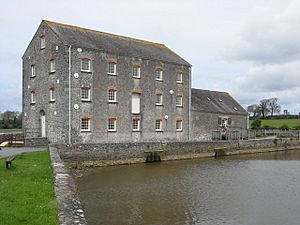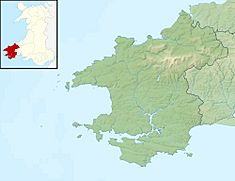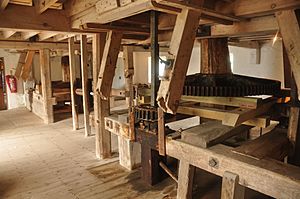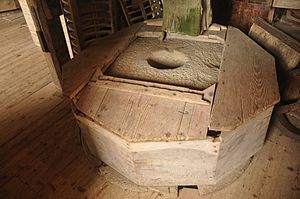Carew Tidal Mill facts for kids
Carew Tidal Mill (which is Melin Caeriw in Welsh) is also known as the French Mill. It's a special kind of mill in Pembrokeshire, Wales, that uses the power of the ocean's tides to grind corn.
This amazing mill was built around 1801. It stands just west of Carew Castle. Before this mill, an even older one stood in the same spot.
Here's how it works: When the tide comes in, open gates let water fill a large pond. At high tide, these gates are closed. As the tide goes out, the water in the pond flows through special channels under the mill. This moving water turns two big water wheels, which then power the millstones inside.
Carew Tidal Mill is the only working tidal mill of its kind left in Wales. It stopped being used in 1937. But it was fixed up in 1972 and is now a museum you can visit!
Contents
Where is Carew Tidal Mill?
Carew Tidal Mill is located on the south side of a long pathway. This pathway, about 150 meters long, crosses the Carew River. The river is a tidal inlet, meaning it's affected by the ocean's tides. It's found east of Milford Haven.
Just 300 meters to the east of the mill is Carew Castle. This castle was built way back in 1270. Long before the castle, an Iron Age fort stood on the same spot. Later, around 1100, a Norman knight named Gerald de Windsor built an earth and wood fort there. The castle has been both a strong military base and a fancy home over the years.
The Old Mill and Causeway
There was an even older mill here before the current one. It might have been built around the same time as the castle. This older mill might have used a small stream from the river to power it. This was before the big pathway (called a causeway) was built to create the large tidal pond.
Records from 1541 mention the old mill. Documents from the time of Henry VIII (who was king from 1509 to 1547) talk about "two mills under one roof called le french mills." The name "French Mill" might come from the millstones themselves, which were made from special French stone. In 1558, a man named John Bartlett rented the mill for 10 gold coins a year. The old mill was repaired in 1792 after a fire.
The causeway itself is first mentioned in a document from 1630. It says that about 15 years earlier, Sir John Carew had fixed the causeway walls and floodgates. This causeway is like a dam made of clay and stone. It holds back the water to create the 11-hectare mill pond. The pond is about 13 meters wide where the mill stands. It gets narrower to about 4.5 meters at the north end, where there's a spillway for extra water. There are also floodgates in the middle of the causeway dam.
How the Mill Works
The Carew Tidal Mill you see today has two big water wheels. One of them even has the date "1801" carved on it, which is why we think the mill was built around that time.
Here's how the mill uses the tide:
- When the tide comes in, the floodgates in the causeway dam are opened. This lets the mill pond fill up with water.
- Once the tide is high, the gates are closed. This traps the water in the pond.
- When the ocean tide starts to go out, the water level in the pond is much higher than the river outside.
- The miller then opens special gates called sluice gates. This lets the water from the pond rush through channels under the mill.
- The rushing water pushes against the paddles of the water wheels, making them spin.
Both water wheels are "undershot," meaning the water flows under them to make them turn. They are about 4.8 meters tall and have wooden paddles. One wheel is 1.65 meters wide, and the other is 2.1 meters wide. Both have strong, square shafts that are 225 millimeters thick.
Inside the Mill Building
The mill building itself is made of stone and has three floors, plus an attic, and a slate roof. It's quite large, with five sections along its length and two sections across its width.
- Ground Floor: Here, you'll find the machinery that lifts the sluice gates. There's also equipment for the "running stones," which are part of the grinding process.
- Stone Floor: This is the main grinding floor. There are six pairs of millstones here. Three pairs are powered by one water wheel, and the other three by the second wheel. This floor also has machines for cleaning the grain and for separating the flour from the bran (the outer part of the grain).
- Bin Floor: Above the stone floor are large grain hoppers. These are like big funnels where the grain is stored before it's sent down to be ground.
- Attic (Garner Floor): A special hoist was used to lift sacks of grain all the way up to the attic. From there, the grain was poured down to a machine called a winnower on the stone floor. This machine blew away the light husks (chaff) from the grain.
After cleaning, the grain was hoisted back up to the attic and stored in the big bins on the bin floor. When it was time to grind, the grain would slide down chutes to the millstones on the stone floor. The millstones would grind the grain into "meal." This meal was then hoisted up again and poured down to the "flour dresser." This machine separated the meal into fine white flour and bran.
The miller's house was right next to the mill. This was very important because the mill could only operate when the tide was going out, which could happen at any time of day or night! Grain would arrive at the mill by cart or by sailing boats, and the finished flour would also be shipped out by boat.
History of the Mill
In the 1600s, Pembrokeshire was known for sending corn to other parts of Wales and England. Carew Tidal Mill was first used during the Napoleonic Wars (early 1800s) to grind corn.
Later in the 1800s, traditional mills like Carew faced tough competition. New steam-powered mills were built in port towns. These new mills could grind cheaper corn that was brought in from other countries. At the same time, the railway came to Pembrokeshire, which made dairy farming more popular. So, the Carew mill started grinding bones for fertilizer and making animal feed instead of just corn.
The mill was described as "falling apart" in the 1870s. It stopped being used completely after 1937. To try and save it, metal bars were put on the south side of the building. But even with these, the building was still in danger of collapsing. In September 1971, the mill was given a special "Grade II* listing," meaning it was a very important historic building.
Restoration and Museum
Money for fixing up the mill came from the Historic Buildings Council of Wales, the Pembrokeshire County Council, and the Pembroke Rural District Council. The restoration work was finished in 1972. It was even recognized with an award!
In 1983, the mill was leased to the Pembrokeshire Coast National Park Authority. Over the next three years, more work was done. They created a welcome area and a milling museum inside the mill. All the repairs and improvements cost about £100,000. This included major work to strengthen the building, new windows, and improvements to the inside. They also added a small reception area and a room for showing videos.
By 1998, the mill's machinery and the south waterwheel were working again! Carew Tidal Mill is the only tidal mill in Wales that has been fully restored and is now open to the public.
Images for kids
-
Remains of a water wheel
-
A vertical drive shaft that powers a horizontal drum
-
Transmission gears. The screw above powers the wheel below.












